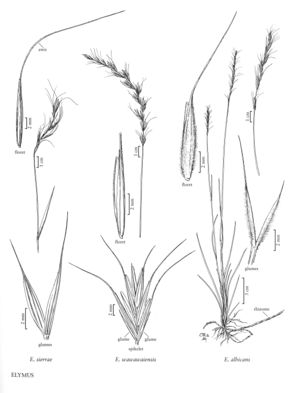Elymus wawawaiensis
Plants cespitose, sometimes weakly rhizomatous. Culms (15) 50-130 cm, erect, mostly glabrous; nodes usually glab¬rous, sometimes slightly pubescent. Leaves more or less evenly distributed; basal sheaths glabrate, margins not evidently ciliate; auricles absent or to 1.2 mm; ligules 0.1-1.1 mm; blades to 28 cm long, 1.7-5 mm wide, involute when dry, adaxial surfaces usually densely pubescent, rarely sparsely pubescent. Spikes 5-20 cm long, 2.5-3 cm wide including the awns, erect to slightly nodding, with 1 spikelet per node; internodes 5-12 mm long, about 0.2 mm thick, about 0.3 mm wide, glabrous beneath the spikelets. Spikelets 10-22 mm long, about twice as long as the internodes, 2-8.5 mm wide, appressed, with 4-10 florets; rachillas glabrous; disarticulation above the glumes, beneath each floret. Glumes 4-10 mm long, 0.5-1.3 mm wide, narrowly lanceolate, widest at or below midlength, glabrous, often glaucous, 1-3-veined, flat or weakly keeled, margins 0.1-0.2 mm wide, widest near midlength, apices usually acuminate, awned or unawned, awns to 6 mm; lemmas 6-12 mm, smooth or slightly scabrous, margins often sparsely pubescent proximally, apices awned, longest awns in the spikelets 9-28 mm, strongly divergent; paleas 7.2-10.5 mm, keels scabrous distally, tapering to the 0.2-0.3 mm wide apices; anthers 3.5-6 mm. 2n = 28.
Distribution
Idaho, Oreg., Wash.
Discussion
Elymus wawawaiensis grows primarily in shallow, rocky soils of slopes in coulees and reaches of the Salmon, Snake, and Yakima rivers of Washington, northern Oregon, and Idaho. There are also a few records from localities at some distance from the Snake River and its tributaries. These probably reflect deliberate introductions. C.V. Piper, who worked for the U.S. Department of Agriculture in southeastern Washington from 1892-1902, frequently distributed seed to farmers in the region from populations that he considered superior; he considered E. wawawaiensis to be a superior form of what is here called Pseudo-roegneria spicata (p. 281). Another source of introduced populations is 'Secar', a cultivar of E. wawawaiensis that is recommended as a forage grass for arid areas of the northwestern United States.
Elymus wawawaiensis resembles a vigorous version of Pseudoroegneria spicata, and was long confused with that species. It differs in its more imbricate spikelets and narrower, stiff glumes. In its primary range, E. wawawaiensis is often sympatric with P. spicata, but the two tend to grow in different habitats, E. wawawaiensis growing in shallow, rocky soils and P. spicata in medium- to fine-textured loess soil. The two species also differ cytologically, E. wawawaiensis being an allo-tetraploid, and P. spicata consisting of diploids and autotetraploids.
Selected References
None.
Lower Taxa
"decumbent" is not a number.No values specified.
